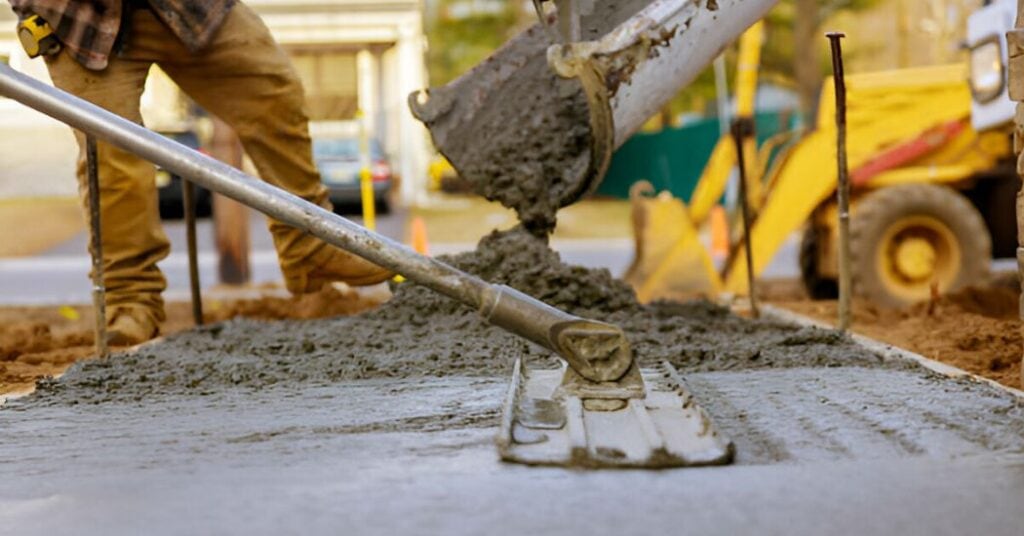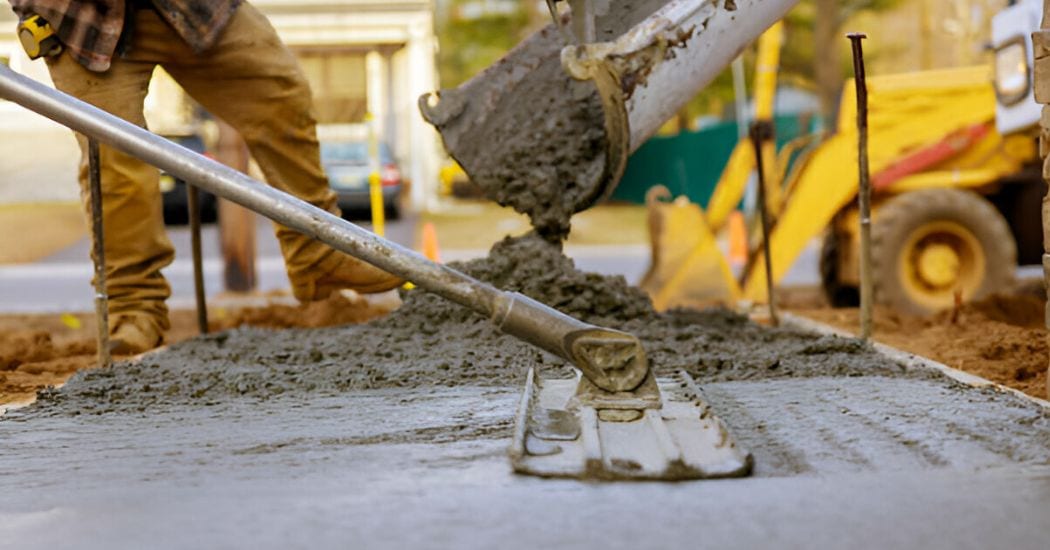We’ve poured our fair share of concrete over the years. And let us tell you, WEATHER can make or break a concrete project.
You might be thinking, “It’s just a little sun or rain, what’s the big deal?” But trust us, the weather can have a HUGE impact on how your concrete pours, sets, and cures.
So, let’s dive into the NITTY-GRITTY of how different weather conditions can affect your concrete!
Understanding the Impact of Weather on Concrete
First things first, let’s talk about WHY weather matters when it comes to concrete. You see, concrete is a FICKLE beast. It’s sensitive to temperature, moisture, and even humidity.
When the weather is too HOT, too COLD, too WET, or too DRY, it can cause all sorts of problems – from cracking and crumbling to weak spots and uneven curing.
But don’t worry, we’re here to break it all down for you!

How Hot Weather Affects Concrete Pouring
Ah, summer. The perfect time for pool parties, BBQs, and…concrete pouring? Not so fast! While it might seem like a great idea to pour concrete on a hot, sunny day, it can actually cause some BIG problems.
Challenges of Rapid Setting Times
When the temperature is high, concrete can set MUCH faster than normal. This might sound like a good thing (who doesn’t love a quick-drying project?), but it can actually be a RECIPE FOR DISASTER.
If the concrete sets too quickly, it can be difficult to properly place and finish. It’s like trying to spread peanut butter on toast that’s already been in the toaster for too long – it just doesn’t work!
Increased Risk of Cracking
Another issue with hot weather pouring is CRACKING. When the surface of the concrete dries out faster than the inside, it can lead to unsightly cracks and weak spots.
It’s like when you leave a cake in the oven too long and the outside gets all dry and crumbly while the inside is still gooey. Not a good look for your concrete!
Strategies to Manage Concrete Temperature
So, what can you do to keep your concrete COOL in the heat? Here are a few tricks of the trade:
- Pour early in the morning or late in the evening when it’s cooler
- Use ice water or chilled aggregates in the mix
- Spray the subgrade and forms with cool water before pouring
- Erect temporary shades or wind breaks to protect the concrete
Effective Curing Methods in Hot Weather
Proper CURING is also key in hot weather. You want to keep the concrete moist and at a moderate temperature to ensure it develops strength properly.
Some effective curing methods for hot weather include:
- Misting or fogging the surface with water
- Covering the concrete with wet burlap or plastic sheeting
- Using a curing compound to seal in moisture
How Cold Weather Affects Concrete Pouring
On the flip side, COLD weather can also be a challenge for concrete pouring. When the temperature dips too low, it can slow down the setting process and even FREEZE the concrete before it has a chance to gain strength.
Risks of Freezing During Pouring
One of the biggest risks with cold weather pouring is FREEZING. If the concrete freezes before it sets, it can cause all sorts of problems – from cracking and flaking to complete STRUCTURAL FAILURE.
It’s like trying to build a sandcastle with wet sand that’s been in the freezer – it just doesn’t hold up!
Importance of Insulation and Heating
To prevent freezing, it’s important to INSULATE and HEAT the concrete during cold weather pours. This might involve using:
- Insulated blankets or tarps to cover the concrete
- Heated enclosures or tents to maintain a warm temperature
- Hydronic heating systems to warm the subgrade and forms
Ensuring Proper Strength Development
Cold weather can also slow down the STRENGTH DEVELOPMENT of concrete. Even if it doesn’t freeze, concrete that cures at low temperatures may not reach its full strength potential.
To ensure proper strength development in cold weather, you might need to:
- Use a higher-strength mix design
- Add accelerators or other admixtures to speed up setting
- Extend the curing time to allow for slower strength gain
Effects of Rainy Weather on Concrete Integrity
Rain, rain, go away…especially if you’re trying to pour concrete! While a little drizzle might not seem like a big deal, too much WATER can seriously mess with your concrete’s integrity.
Risks Due to Water Exposure
When concrete is exposed to excessive water during pouring or curing, it can cause all sorts of issues, like:
- Weakening the cement paste and reducing strength
- Causing surface erosion and pitting
- Leaching out important minerals and additives
- Creating a blotchy, discolored appearance
Proactive Protection Methods
So, how do you keep your concrete HIGH AND DRY during rainy weather? Here are a few proactive protection methods:
- Cover the concrete with waterproof tarps or plastic sheeting
- Use a sealant or curing compound to prevent water infiltration
- Provide adequate drainage around the pouring site
- Consider adding water-reducing admixtures to the mix
The Role of Humidity in Concrete Curing
Humidity might not be the first thing you think of when it comes to concrete, but it can actually have a BIG impact on how your concrete cures.
Understanding Humidity Levels
Humidity is basically the amount of MOISTURE in the air. It’s usually measured as a percentage – with 100% being totally saturated (think a steamy rainforest) and 0% being bone dry (like the Sahara desert).
How Humidity Influences Setting Times
The humidity level can affect how quickly your concrete SETS and CURES. In general:
- High humidity (over 80%) can slow down setting and curing
- Low humidity (under 40%) can cause the surface to dry out too quickly
The sweet spot for concrete curing is usually between 40-80% humidity.
Temperature Fluctuations and Their Consequences
Even if you manage to pour your concrete in PERFECT weather conditions, temperature changes during the curing process can still cause problems.
Day-Night Temperature Variations
One common issue is DAY-NIGHT temperature variations. If the temperature swings too much between the heat of the day and the cool of the night, it can cause the concrete to EXPAND and CONTRACT unevenly.
This can lead to cracking, curling, and other types of DAMAGE.
Impact on Curing and Strength
Temperature fluctuations can also mess with the CURING process and affect the final strength of the concrete.
For example, if the temperature drops too low at night, it can slow down or even HALT the hydration reaction that makes concrete harden. This can result in WEAKER, less durable concrete.
Best Practices for Pouring Concrete in Various Weather Conditions
Alright, so we’ve covered all the ways weather can WREAK HAVOC on your concrete. But fear not! There are some BEST PRACTICES you can follow to ensure a successful pour, no matter the forecast.
Planning and Timing
First and foremost, it’s all about PLANNING and TIMING. Before you even think about pouring, check the weather forecast and plan accordingly.
If possible, try to schedule your pour for a time when the weather will be most COOPERATIVE – not too hot, not too cold, not too wet.
And always have a BACKUP PLAN in case Mother Nature throws you a curveball!
Choosing the Right Mix Design
Another key factor is CHOOSING THE RIGHT MIX DESIGN for the weather conditions. Different mix designs can be more or less resistant to the effects of hot, cold, or rainy weather.
Work with your concrete supplier to select a mix that will perform well in the expected conditions. This might involve adjusting the cement content, water-cement ratio, or adding SPECIAL ADMIXTURES.
Utilizing Additives for Weather Challenges
Speaking of admixtures, they can be a GAME-CHANGER when it comes to pouring concrete in challenging weather. There are all sorts of additives that can help your concrete BEAT THE HEAT, FIGHT THE COLD, or STAY STRONG in the rain.
Some common additives for weather challenges include:
- Accelerators to speed up setting in cold weather
- Retarders to slow down setting in hot weather
- Water reducers to maintain workability with less water
- Air entrainers to improve freeze-thaw resistance
- Corrosion inhibitors to protect reinforcement in wet conditions
Of course, it’s important to use these additives CORRECTLY and in the right proportions. Consult with a concrete professional (like us!) to get the right mix for your project.
The Bottom Line
At the end of the day, WEATHER is one of the biggest factors that can affect your concrete pouring and setting. But with the right knowledge, planning, and techniques, you can CONQUER even the most challenging conditions.
As your local concrete experts, we’ve seen it all – from scorching heat waves to frigid cold snaps. And we’ve learned a thing or two about how to pour and cure concrete that STANDS THE TEST OF TIME (and weather!).
So, whether you’re a DIY enthusiast or a seasoned pro, keep these weather tips in mind for your next concrete project. And if you ever need a hand (or just want to talk shop), give Boise Concrete Contractor a call! We’re always here to help you WEATHER any concrete storm.
